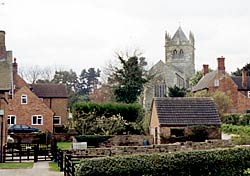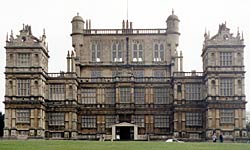News for Winter 2004
Assistant Secretary – Excursions
Council is looking for a member to act as Assistant Secretary – Excursions. Currently most of the work of organising and running our excursions programme falls to the Treasurer and the Programme Secretary. They have asked Council to appoint a new position to be entirely connected with the excursions programme, which will be appropriate for a member who regularly attends Thoroton Society excursions.
The person appointed will not be expected to organise and lead all the excursions, but will be required to undertake some of the administration that is involved, including attending the excursion (if possible). Further details can be obtained from Thoroton Society Treasurer, Keith Goodman, telephone 0115 9726590, or at his email address, thoroton@keithgoodman.com.
 |
AGM 2005 AT LAXTON
A note for your diary – advance notice of the Annual General Meeting on 30 April 2005 – this year it will be held at Laxton. The meeting itself will be in the village hall, and members will be provided with the usual country-style tea. The highlight of the day will be the opportunity to visit Laxton Castle, the site of one of the most important Norman castles in the county, and one which is the focus of archaeological investigation by Sarah Speight, Council member, and Keith Challis. Sarah will be on hand to explain the work that has been going on and the recent findings. It should be a good afternoon out. John Beckett
Congratulations
- Dr Sarah Speight, our Archaeology editor and CBA representative, who was married to Anthony Epworth on 23 October 2004.
- Steph Mastoris, who has left Snibston Discovery Park for a new job in Swansea. His email remains the same at stephmastoris@tiscali.co.uk
 |
Wollaton Hall
Newsletter No.37 contained a note about Peter Smith's recent paper on ‘The Sundial Garden and the House-plan mount, two gardens at Wollaton Hall, Nottinghamshire by Robert (c1535-1614) and John (-1634) Smythson’. A copy has now been deposited in Bromley House Library to join his earlier papers on Welbeck, Clifton Hall and Nuthall Temple. Society Members, if not members of the library, may consult them by prior arrangement with the Librarian, tel 0115 9473134. Neville Hoskins
Nottinghamshire Bibliography: Correction
The Society’s Record Series Vol 42: A Nottinghamshire Bibliography; Publications on Nottinghamshire History before 1998, which appeared in 2002, contains the following error. Entry No 2527 refers to Nottinghamshire History and Topography: A Select Descriptive Bibliography, published by the late Michael Dobbin, a former Hon. Secretary of the Society, and the statement is there made that Mr Dobbin’s own collection of Nottinghamshire books was ‘now owned by the Nottingham Subscription Library’. It has been pointed out that this collection is simply lent to the Nottingham Subscription Library at Bromley House, Nottingham, and continues to be owned by the Dobbin Family. The Society is happy to correct the error and apologizes both to the family and the Library for any embarrassment that this may have caused.
GEORGE F. CAMPION
In Newsletter 37 John Beckett asked whether anyone in the Society remembers George Campion. Bernard Beilby has come up trumps! Here are his reflections:
‘The first time I met George Campion was in 1938 when he was director of excavations for the Thoroton Society Excavation Section. They were exploring the caves in Broad Marsh/Drury Hill. Entrance was gained through a small hole in a brick wall at the back of the Royal Oak Public House in Broad Marsh.
‘Although George had been a director of the Campion Motor Cycle Company, like his father E.W. Campion, archaeology had been a life long interest and he took early retirement so that he could devote more time to his hobby. He did a great deal of work in the caves of Nottingham as well as at Lenton Priory, Thurgarton, and many other sites, including rescuing two Bronze Age canoes from the River Trent. In a cave on Fletcher Gate we excavated a well and before it was refilled he buried a box containing a glass jar with newspapers, coins, etc. at the bottom. He was a genius at finding artefacts, particularly complete medieval Nottingham pots, though his interpretation of the finds often left a good deal to be desired.
‘In his Antiques Restoration Laboratory in Castle Place Campion had a huge collection of green glaze pots which he had left in his will to the Castle Museum, but as a result of their lack of interest he sold them to Birmingham Museum. Amongst his collection was a sword allegedly found by his father in a stone coffin in front of the High Altar at Lenton Priory: personally I thought it was more likely to be 17th/18th century.
‘During the war years Campion kept the interest in archaeology alive at a time when it was largely a non-professional hobby. When we all returned from the Services he soon gathered a group of like-minded people around to do the hard work. We regularly met in his workshop on Saturday morning, often watching him repairing valuable antiques. Pre-war Campion had excavated a medieval plague pit where he contracted a serious illness resulting in him losing all sense of taste and smell. After his death in March 1955, aged 66, his son-in-law Herbert Holdsworth inherited his notes and records, but did not long survive him, and these have since disappeared. Bernard W. Beilby
BOOKSTALL
Byron Barrett, who sadly died last year, was for many years the ‘guardian’ of the bookstall books. Between meetings the books were stored in his garage together with a green baize cloth to cover the table. After the books were reclaimed and stored in Shakespeare Street this cloth somehow disappeared.
However, Byron had very generously donated a sum of money to the Society, and with a part of this legacy we have bought a new and splendid velvet cloth in ‘Thoroton’ green. I hope members will come to admire this and remember Byron whenever they visit the bookstall at future meetings. Penny Messenger
Southwell and the Slave Trade!
Thoroton member Bob Hardstaff, whose book on the Southwell Domesday Survey was published last year by the Southwell and District Local History Society, has written another, on a rather controversial subject, which is due to appear in December.
Entitled Human Cargo and the Southwell Connection, its subject is the Slave Trade, now viewed with abhorence, but in the eighteenth century a major part of the history of places such as Liverpool, Bristol and, somewhat surprisingly, Southwell. Much of the money which enabled Southwell's affluent families to maintain their lifestyle and to build some of their still-existing houses was derived from voyages of vessels like the Jason Galley whose 6,000 mile trip in 1743 Mr. Hardstaff has examined in great detail. John Beckett
The views expressed in the Newsletter are not necessarily those of the Editor, the Society or its Council.